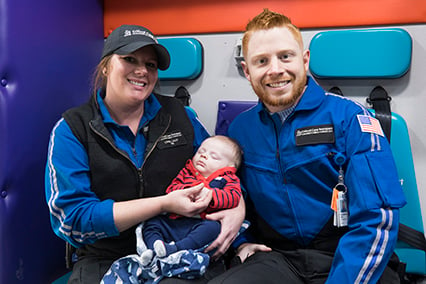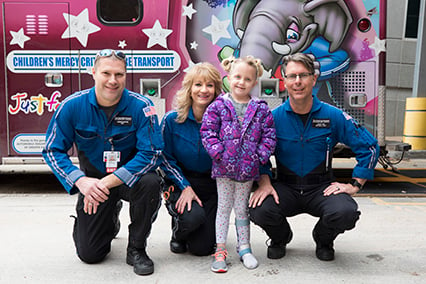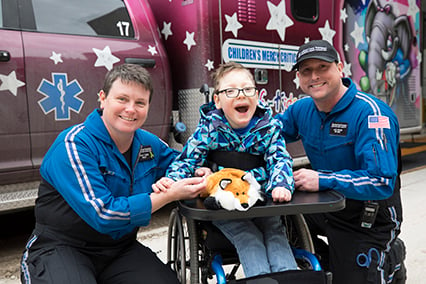Critical Care Transport: Meet Knox
From the beginning, Knox Yurth was a happy, healthy baby. So, when he began crying inconsolably at only 3 weeks old, mom Kristin felt in her gut that something must be wrong.
“Our first child had colic, so I knew what that was like, but this was much worse,” Kristin described. “Out of 48 hours, Knox probably cried all but three.”
The crying began on a Sunday. The next morning, Kristin took Knox to the pediatrician. Despite a physical exam, as well as multiple X-rays and ultrasound exams, all testing came back normal.
Back home, Kristin tried and tried to comfort her son, but he continued to cry throughout the night. The next morning, he had what looked like a blister around his mouth.
“It almost looked like a burn,” Kristin said. “I took Knox back to the pediatrician. While at the office, blisters started forming around his eyes and ears, and his little body was bright red.”
The pediatrician suspected Knox had an infection. He called the Children’s Mercy Critical Care Transport team to take him from his St. Joseph, Mo., office to the Children’s Mercy Adele Hall campus.
“I was crying and upset. My husband was out of town for work and I was by myself,” Kristin said. “When the transport team arrived, they were amazing. They were so professional and knowledgeable, but they also comforted me.”
Kristin rode in the ambulance from St. Joseph to Kansas City, receiving constant updates from the staff on Knox’s condition all along the way. One of the team members explained that the service brings the expertise and technology of the pediatric intensive care unit at Children’s Mercy to the patient—wherever and whenever they need it.
When Knox arrived at Children’s Mercy, he was admitted to the PICU. There, the hospital’s infectious diseases experts diagnosed him with scalded skin syndrome, a rare skin condition that occurs primarily in newborns. Caused by the bacteria Staphylococcus aureus, it can result in blistering and peeling of the top layer of skin. When treated early with antibiotics, most children recover quickly.
Fortunately, that was the case for Knox. “We were only in the PICU one night, and in the hospital three days,” Kristin said. “While we were there, two of the transport team members came in to check on Knox. I thought that was awesome. They really seemed to care about him.”
Now 3 months old, Knox’s skin has completely healed. “It’s hard to believe today, but Knox’s skin was literally sloughing off, like a burn patient’s.
“It was so scary when they strapped Knox’s tiny body on the gurney for transport,” Kristin said. “But, I thought, ‘If he has to go somewhere, there’s no better place than Children’s Mercy.’ The transport team was just wonderful. I can’t say enough good things about them!”
Inside Pediatrics: Zei's story
After a mysterious illness ravages Zei’s lungs and leaves her fighting for life, the critical care team re-invents its life support protocols to push the limits of medicine to give her a chance.
Critical Care Transport: Matthew's story
Following the birth of their son, Matthew, first-time parents Natalie and Phillip Meznar noticed something was seriously wrong. Suffering from breathing issues, the Neonatal Transport team at Children's Mercy quickly transported Matthew to the hospital for care, where he was diagnosed with a rare condition called pulmonary arteriovenous malformation, or PAVM.

Critical Care Transport: Paizlee's story
Six-year-old Paizlee received an injury to the head from a game of baseball that caused her brain to swell. Rushing against time, the Children’s Mercy Critical Care Transport team arrived to bring Paizlee to the hospital in time for the care she needed.

Critical Care Transport: Parker's story
Born six and one-half years ago at only 23 weeks, 5 days of gestation, and weighing l pound, 12 ounces, Parker McElroy’s mother, Kylie, said he is alive today thanks to the Children’s Mercy Neonatal Transport team.
